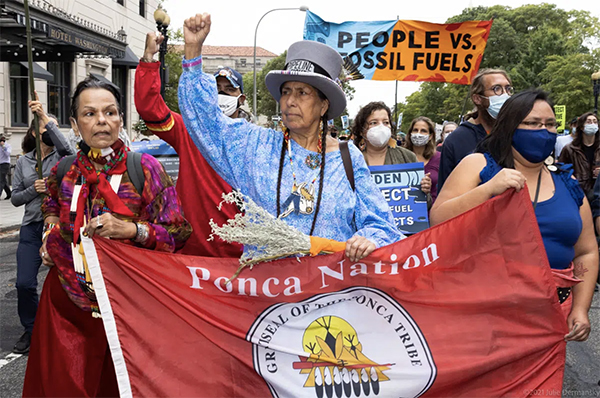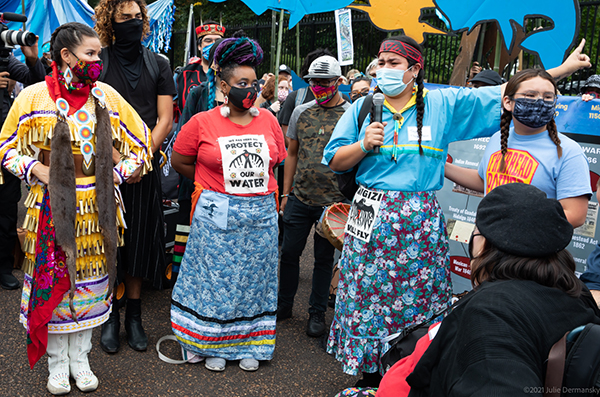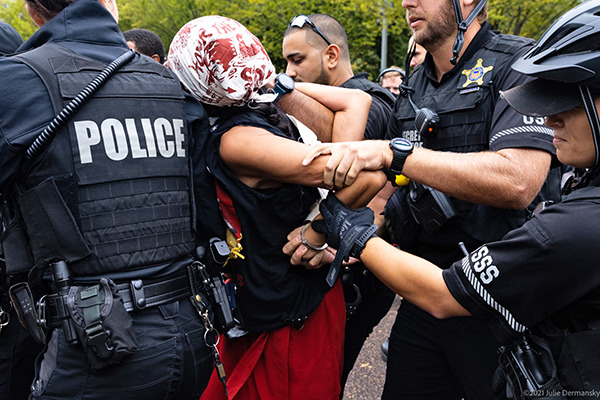Editor’s note: The following are excerpts from multi-media reporter Julie Dermansky’s coverage of the first day of climate protests, which took place over a five-day period beginning on October 11 in Washington, D.C., reprinted with permission. The complete story and photos can be seen at https://www.desmog.com/2021/10/11/indigenous-136-arrested-white-house-fossil-fuel-protest/ You can read Julie Dermansky’s coverage of each of the five days of protests at https://www.desmog.com/user/julie-dermansky/

Photo / Julie Dermansky
On October 11, Indigenous People’s Day, 136 people, including many Indigenous leaders opposing fossil fuel projects, were arrested in front of the White House in Washington, D.C., while calling on President Biden to declare a climate emergency and to stop approving fossil fuel projects. The day marked the first in a five-day-long series of protests in the nation’s capitol organized by the Build Back Fossil Free coalition, which is made up of numerous environmental and social justice advocacy groups.
Over the course of five days, thousands are expected to bring the message to Biden’s door that he must do more to protect the planet, and many demonstrators are coming prepared to participate in acts of civil disobedience, to make sure the President hears their message before next month’s COP26 climate summit in Glasgow, Scotland. These demonstrations, labeled People vs. Fossil Fuels, are being billed as a test for Biden.

Photo/ Julie Dermansky
Pressure on Biden has been rising since he failed to acknowledge vocal, Indigenous-led protests to the Line 3 tar sands oil pipeline, which went online October 1 in Minnesota. As DeSmog recently reported, Indigenous peoples in North America have helped block at least eight major fossil fuel projects, from oil pipelines to LNG export terminals, keeping enormous volumes of carbon pollution out of the atmosphere.
This morning, a few hundred activists marched from Freedom Square to the White House where Indigenous leaders spoke, mostly addressing President Biden, whom they called on to honor his campaign promises to protect the planet.
“We are going to put our bodies on the line there. If we have to be arrested in order to call attention to what the crisis is and that we need a climate emergency declared, we’ll do that,” said Casey Camp Horinek, long-time activist and tribal elder and environmental ambassador for Ponca Nation, located in what’s now Oklahoma. “There’s been 500 years of people coming into a territory where all things were interdependent and functioning to a time of crisis, where even Biden’s great-grandchildren won’t survive if something doesn’t change.”
“Joe Biden, you have been making false promises. You stopped Keystone XL — what about DAPL, Line 5, MVP?” Joye Braun, a member of the Cheyenne River Sioux and a national pipeline campaign organizer with the Indigenous Environmental Network, said following Horinek. “Biden has turned a fork tongue, and he needs to be held accountable to the promises he made to Indigenous nations when we helped elect him.” She added, “This is indigenous land. Indigenous peoples will be here for thousands of years. Biden, can you hear us now?”
Both Horinek and Braun were among those arrested during a sit-in at the White House fence.
“People are dying right now from the pollutants, the toxins, the climate catastrophes that are happening, and we have to stop the harm,” Siqiñiq Maupin, the executive director of Sovereign Iñupiat for a Living Arctic, told the crowd. She added that Biden relied on people of color, including Indigenous people, to get into office by promising to tackle climate change but that as President he is continuing to sacrifice their lives for oil and
gas. . .
While the day’s event was mostly peaceful, tensions arose when Erica Jones, a member of the Crow Creek Sioux Tribe, who was not among those planning to be arrested, was handcuffed by law enforcement and taken away from the group of protesters across from the White House . . .

Photo / Julie Dermansky
While those who remained in front of the White House were being led away to be processed in tents nearby, the crowd cheered them on from Lafayette Square. Among them was a young girl who chanted, “Thank the water protectors,” over and over. She was given a megaphone and then led a “Water is life” chant, a rallying cry borne out of the Indigenous-led movement against the Dakota Access pipeline in North Dakota.

